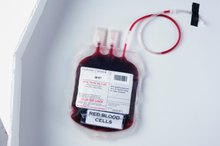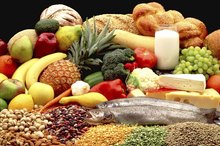What does fact checked mean?
At Healthfully, we strive to deliver objective content that is accurate and up-to-date. Our team periodically reviews articles in order to ensure content quality. The sources cited below consist of evidence from peer-reviewed journals, prominent medical organizations, academic associations, and government data.
- Mayo Clinic: Low Potassium
- MedlinePlus: Hypokalemia
- National Heart Lung and Blood Institute: What Causes Iron-Deficiency Anemia?
- National Heart Lung and Blood Institute: What Causes Iron-Deficiency Anemia?
The information contained on this site is for informational purposes only, and should not be used as a substitute for the advice of a professional health care provider. Please check with the appropriate physician regarding health questions and concerns. Although we strive to deliver accurate and up-to-date information, no guarantee to that effect is made.
Facts About Low Potassium & Low Iron
Potassium and iron are two minerals required to keep your body functioning properly. When you have low levels of either mineral, you can experience serious and sometimes life-threatening side effects. A knowledge of the symptoms of low levels of each ensures you recognize warning signs before your levels dip too low.
Normal/Low Levels
Both potassium and iron levels can be determined by a simple blood test. The normal potassium levels in the blood range from 3.6 to 4.8 milliequivalents per liter, according to the Mayo Clinic 1. Low potassium levels—also known as hypokalemia—are defined as less than 2.5 milliequivalents per liter 12. Anemia tests measure the amount of hemoglobin—the substance that moves red blood cells—in the body, according to the National Anemia Action Council. Low levels are considered anything less than 13g per deciliter. However, severe anemia occurs when a person’s levels drop below 8g per deciliter.
- Both potassium and iron levels can be determined by a simple blood test.
- However, severe anemia occurs when a person’s levels drop below 8g per deciliter.
Causes
Does Iron Deficiency Cause Headaches?
Learn More
Low iron levels occur with insufficient dietary intake, after a growth spurt, during pregnancy or after you have lost a significant amount of blood, such as after surgery or an injury, according to the American Academy of Family Physicians. Causes of low potassium include:
- use of diuretics
- chronic diarrhea
- kidney failure
- frequent vomiting
- abuse of laxatives
- according to the Mayo Clinic 1
Symptoms
Symptoms of low potassium include:
- weakness
- trouble moving the muscles
- muscle cramps
- constipation
- an irregular heartbeat
- in severe instances
- according to the Mayo Clinic 1
Anemia, on the other hand, may not cause symptoms until levels have dropped very low, according to the American Academy of Family Physicians. They can include
- palor
- fatigue
- shortness of breath
- rapid heartbeat
- cold extremities
- brittle nails
- dizziness
Prevention
Are Night Sweats & Weight Loss Symptoms of Anemia?
Learn More
A healthy diet varied in food selections can help to fight both anemia and hypokalemia—except in the instances of body malfunction, such as kidney failure 2. Foods high in potassium include:
- bananas
- bran
- granola
- kiwi
- lima beans
- milk
- peaches
- peanut butter
- beans
- peas
- according to MedlinePlus 2
Foods high in iron include meats, such as
- liver
- seafood
- dried fruits
- nuts
- beans
- spinach
- whole grains
- foods fortified with iron
- according to the American Academy of Family Physicians
Warning
While taking iron or potassium supplements can help to raise your mineral levels, they can be accompanied by harmful side effects. For example, iron pills can cause constipation and nausea, according to the American Academy of Family Physicians. Those who take potassium supplements, yet still experience low levels may need to be given intravenous potassium, according to MedlinePlus 12.
Related Articles
References
- Mayo Clinic: Low Potassium
- MedlinePlus: Hypokalemia
- National Heart Lung and Blood Institute: What Causes Iron-Deficiency Anemia?
- Dylewski JF, Linas S. Variability of potassium blood testing: Imprecise nature of blood testing or normal physiologic changes? Mayo Clinic Proceedings. 2018. 93(5):551-554. doi:10.1016/j.mayocp.2018.03.019
- Friedman PA, Scott CG, Bailey K, et al. Errors of classification with potassium blood testing: The variability and repeatability of critical clinical tests. Mayo Clinic Proceedings. 2018;93(5):566-572. doi:10.1016/j.mayocp.2018.03.013
- Galloway CD, Valys AV, Shreibati JB, et al. Development and validation of a deep-learning model to screen for hyperkalemia from the electrocardiogram. JAMA Cardiology. 2019. 4(5):428-436. doi: 10.1001/jamacardio.2019.0640
- National Heart, Lung, and Blood Institute. Blood tests.
- Ialongo C, Bernardini S. Phlebotomy, a bridge between laboratory and patient. Biochem Med (Zagreb). 2016;26(1):17–33. doi:10.11613/BM.2016.002
- Schmidt ST, Ditting T, Deutsch B, et al. Circadian rhythm and day to day variability of serum potassium concentration: A pilot study. Journal of Nephrology. 2015. 28(2):165-72. doi:10.1007/s40620-014-0115-7
- Chatterjee R, Yeh HC, Shafi T, et al. Serum potassium and the racial disparity in diabetes risk: the Atherosclerosis Risk in Communities (ARIC) Study. American Journal of Clinical Nutrition. 2011. 93(5):1087-91. doi:10.3945/ajcn.110.007286
- Cleveland Clinic. Hyperkalemia (high blood potassium). Updated October 19, 2016.
- Cleveland Clinic. Low potassium levels in your blood (hypokalemia). Updated March 12, 2018.
- Kardalas E, Paschou SA, Anagostis P, et al. Hypokalemia: a clinical update. Endocrine Connections. 2018;7(4):R135-R146. doi:10.1530/EC-18-0109
- Cleveland Clinic. Low potassium levels in your blood (hypokalemia): Management and treatment. Updated March 12, 2018.
- Bnaya A, Ruchlemer R, Itzkowitz E, Gabbay E, Shavit L. Pseudohyperkalemia in chronic lymphocytic leukemia. American Journal of Medicine. 2020;133(2):e52-e53. doi:10.1016/j.amjmed.2019.07.037
- Ben Salem C, Badreddine A, Fathallah N, Slim R, Hmouda H. Drug-induced hyperkalemia. Drug Safety. 2014. 37(9):677-92. doi:10.1007/s40264-014-0196-1
- Cleveland Clinic. How can hyperkalemia (high blood potassium levels) be treated? Updated October 19, 2016.
- Miller KC. Plasma potassium concentration and content changes after banana ingestion in exercised men. J Athl Train. 2012;47(6):648–654. doi:10.4085/1062-6050-47.6.05
- American Association for Clinical Chemistry. Potassium. Updated 12/13/19.
- Jameson JL, et. al. Harrison's Principles of Internal Medicine, 20th Edition. McGraw Hill Education. 2018.
- Kovesdy CP, Appel LJ, Grams ME, et al. Potassium homeostasis in health and disease: A scientific workshop cosponsored by the National Kidney Foundation and the American Society of Hypertension. Journal of the American Society of Hypertension. 2017;11(12):783-800. doi:10.1016/j.jash.2017.09.011
- Nilsson E, Gasparini A, Arnlov J, et al. Incidence and determinants of hyperkalemia and hypokalemia in a large healthcare system. International Journal of Cardiology. 2017;15;245:277-284. doi:10.1016/j.ijcard.2017.07.035
- Pagana KD, Pagana TJ, Pagana TN. Mosby’s Diagnostic & Laboratory Test Reference. 14th ed. St. Louis, Mo: Elsevier; 2019.
- Schrier RW. Renal and Electrolyte Disorders, 8th Edition. LWW. 2017.
- Shrimanker I, Bhattarai S. Electrolytes. in: StatPearls. Updated January 20, 2020.
Writer Bio
Rachel Nall began writing in 2003. She is a former managing editor for custom health publications, including physician journals. She has written for The Associated Press and "Jezebel," "Charleston," "Chatter" and "Reach" magazines. Nall is currently pursuing her Bachelor of Science in Nursing at the University of Tennessee.









